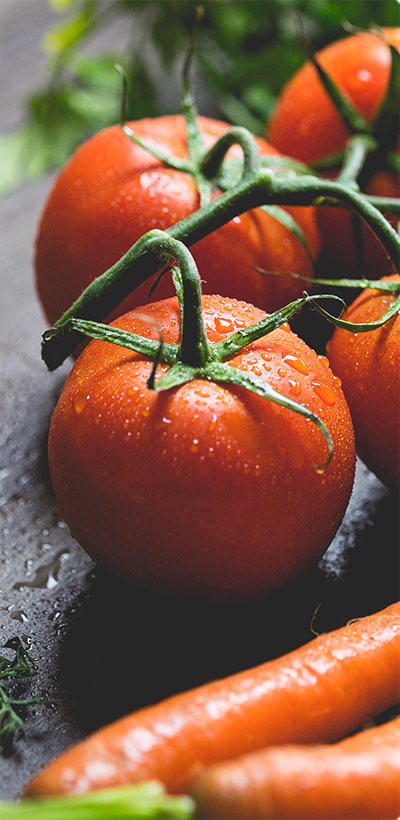Esterina Tomato
Esternia produces slightly oval shaped bright yellow cherries in long clusters with a very sweet flavour. An indeterminate vine that is vigorous and highly productive. Days to Maturity 60-65 days after transplant. Approx. 10 seeds/pkg. Untreated seed only.
Indeterminate plants are tall, require staking and produce tomatoes over a longer period of time. Instead of having one large harvest at once, they bear over a period of months. These are perfect for home gardeners who want their harvest spread out, or greenhouse growers that want tall plants to best use their space.
Scroll down for more details and growing information.

Details
Growing Information
Planting:
Tomatoes are tender plants and are very susceptible to frost damage. Start seeds indoors 6-8 weeks before the last frost date in your area. Sow 1 seed in 1x1 inch cell. Cover seed with 1⁄4 inches soil and provide a constant soil temperature of 21-24°C.
After plants develop 1-2 sets of true leaves, transplant into 4-4.5” pots. Use a water-soluble fertilizer every two weeks.
Provide lots of light, 10-12 hours a day. Without sufficient light, seedlings will become tall and spindly. If you use a windowsill for your light source, be aware that it may get very hot on sunny days and very cold at night. Plants may dry out or get frost or heat damage. Turn containers frequently dissuading elongation.
Water when potting mix is dry to the touch. Feed regularly with any balanced vegetable tomato liquid fertilizer or organic equivalent. Feed once a week with half rate fertilizers or once every two weeks with full rate. You may also use a slow-release fertilizer especially for containers.
Moving Outside:
Gradually adjust your plants to outside conditions over a period of a week or two. First place them outside on a warm, calm day in the shade for a few hours. Work up to more sun, wind, and cooler temperatures and finally leave out overnight. Transplant outdoors after all danger of frost has passed. When transplanting, space 24-36” apart with rows at least 36-48” apart.
Growing:
Full sun location, with good air circulation. Soil should be well drained and fertile. Amend soil with compost or well-rotted manure prior to planting. Feed regularly during the growing season with compost tea or well-balanced liquid fertilizer or incorporate a pelleted fertilizer. Avoid excessive nitrogen, particularly before flower or fruit set. Provide even moisture during fruit set and development. Excessive watering can increase fruit size but decrease flavour.
Pruning:
Determinate Tomatoes are tomato plants with a set amount of growth and yield and do not require pruning. Determinate tomatoes typically do not require staking and produce all fruit at the same time.
Indeterminate Tomatoes will continue to grow and produce fruit until the first hard frost. Pruning removes unwanted growth and redistributes energy that would have been used for the unwanted growth in other areas of the plant like fruit production. Leaving indeterminate tomatoes unpruned is not detrimental to the plant’s health and growth. In fact, many gardeners do not prune their tomatoes and still get plentiful yields. By pruning, you are taking the next step in producing bigger and more flavourful tomatoes.
What is a Tomato Sucker?
Tomato suckers, or side shoots, are small shoots that grow points of growth like between a branch and main stem, or roots of the plant (also called the axil). If left unattended, they will eventually grow into branches that produce leaves, flowers, and fruit, resulting in stollen energy from the plant.
How to Prune Tomatoes:
Once your tomato starts producing its first flower cluster, you are ready to start pruning.
Disinfecting your fingers or pruners between plants will also help reduce the spread of disease and bacteria. Hand sanitizer for your hands or 70% isopropyl alcohol for pruners work well.
The sucker located just below the first flower cluster will stay. This will become another stem that will produce leaves and fruit. All other suckers below this sucker can be removed. You can remove suckers by pinching between your thumb nail and index finger or use precession pruners.
Once you see fruit starting to form, leave some suckers to protect the fruit from Sunscald (a sunburn on tomato fruit).
Continue this process throughout the growing season.
Harvesting:
Pick fruit firm but with a little give and when fruit is half coloured. Overripe tomatoes rot quickly. Tomatoes will ripen off the vine if there is any colour showing.
Pests & Diseases:
Protect from cutworms by using protective collars around the plant stem or place cornmeal around plant base. Blossom end rot (a brownish-black, sunken dead area that forms on the bottom of the fruit) is a condition caused by a calcium deficiency due to uneven watering. Blight, another disease common to tomatoes is caused by warm, humid conditions particularly if plants have not been given some support to keep foliage off the ground. Use copper or sulphur sprays to help prevent blight. Good air circulation along with proper rotation will help to prevent onset of this harmful disease.
Companions:
Asparagus, basil, bush bean, cabbage, carrot, celery, chive, cucumber, lettuce, onion, pepper.



